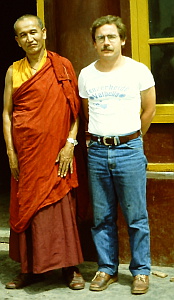| < Prev | Next > |
|---|

The photos for the slide shows of this site were nearly all taken during several trips to Nepal, India and Burma that I made between 1979 and 1983.
Many of these images are now historic documents. Especially the landscape scenes in Kathmandu valley do no longer exist in this way.
Nepal Once ...
The worst changes in this period of more than 30 years have taken place in Kathmandu valley. The total population for Kathmandu valley was estimated at roughly 600,000 in the late 1970s. There were practically no cars in 1979 except for a number of Japanese taxis. New Road - one of Kathmandu's main roads in the center - was populated by cows. There was no TV in Nepal in 1979.
... and Nepal Now
By 2010 the population in Kathmandu valley had increased by a factor of 10 to circa 6 million. The inevitable consequences were a huge urbanization that destroyed the rural landscapes that you can see on my old images. Unfortunately the infrastructure has not kept up with this development. As a consequence the inadequate network of roads and streets cannot cope with an ever growing number of cars and motor bikes. Traffic in Kathmandu is a daily madness beyond imagination. The environmental pollution is a disaster.
Handicraft in Nepal in 2010
In 2008 I went back to Kathmandu. To my surprise the century old traditions in handicraft and arts were still alive. Thangka painting is even still practiced on a high level. Carpet making had degenerated many years ago by accommodating to Western styles and tastes. But there are still some Tibetans and Nepali weavers who make the old traditional Tibetan designs in excellent quality. And also the famous Nepal copper statues are still made by hand using the lost-wax method as centuries ago. However good qualities and the more sophisticated models of Buddhist and Hindu gods and goddesses are now hard to find.
Birma
 In 1980 Burma was an isolated country ruled by the military that did its best to keep any Western influences out of the country. Travelers to Burma needed a visa that was restricted to 7 days - just enough time to get a short glimpse of the major sightseeing spots of Burma.
In 1980 Burma was an isolated country ruled by the military that did its best to keep any Western influences out of the country. Travelers to Burma needed a visa that was restricted to 7 days - just enough time to get a short glimpse of the major sightseeing spots of Burma.
I saw Rangoon, Mandalay and Pagan. The 7 days in Burma were among my most fascinating traveling experiences. One had the feeling to travel in the nineteenth century. The world of Rudyard Kipling seemed to be alive.
Thirty Years Later
These Asian countries have changed considerably within only 30 years. And so have I, of course. But I have learned for myself that there are always great discoveries of exceptional beauty and fascination to make. It only needs an open eye and the willingness to leave mainstream paths and trust your own judgement.
Dieter Wanczura in 2010







